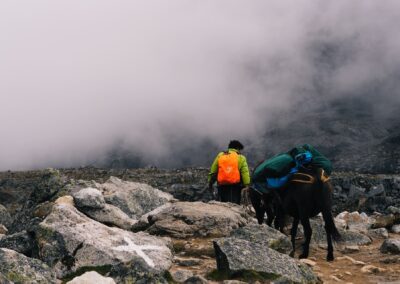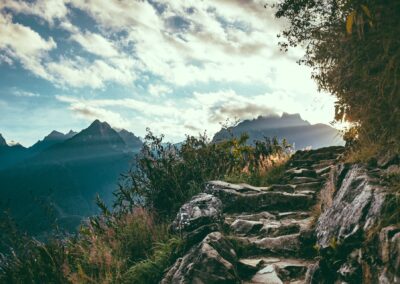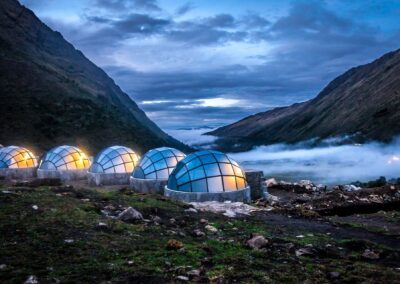Middle Inca Trail
Adventure in 3 Days and 2 Nights
ACTIVITIES
Hike
DURATION
3 Days / 2 Nights
MAX. ALTITUDE
4,200 mts
LOCATION
Ollantaytambo, Aguas Calientes, Machu Picchu
Introduction
The experience of the Middle Inca Trail 03 days and 02 nights is one of the new travel options for lovers of trekking. This new alternative allows us to reach the top of 2 sacred mountains in the Sacred Valley and in Machu Picchu to learn more about the connection between these amazing architectural structures.
This experience is intended for all people who have an adequate and optimal state of health in the face of the necessary requirement, you can do it individually to be able to meet new people, as a couple or with friends with whom to share emotions and also as a family to live a unforgettable adventure.
Get inspired for your next vacation with testimonials from traveling customers like you!
Why book this tour?
Discover the mysterious door of the sun of snowy Veronica.
Capture the best shots of Ollantaytambo and the Cachicata Quarry.
Complete a new challenge over 4,100 msnm.
Complete and overcome the challenging Middle Inca Trail.
Overcome your limits and reach the top of the famous Gringo Killer.
Tour the beautiful Inca citadel and surroundings.
Enjoy the magical train ride in its various classes.
Capture the best shots from the House of the Guardian.
Discover the mystery about the Intihuatana.
Fall in love with the Inca culture with its living history.
Taste the fantastic novoandina and local gastronomy.
Summary Itinerary
Day 01: Adventure in Cachicata – Puerta del Sol
- 08:00 – 08:30 Pick up from your hotel and we go to Ollantaytambo.
- 09:00 – 12:30 Iniciamos la caminata de ascenso hasta la cantera de Cachicata donde disfrutaremos de una vista privilegiada del centro arqueológico de Ollantaytambo. Luego continuaremos nuestro camino hasta llegar a lo alto de la montaña donde podremos disfrutar de nuestro almuerzo que llevamos.
- 13:00 – 15:00 We continue our way to the next mountain where we can find the door of the sun, our final destination. This beautiful place is located in the highest part of the mountain.
- After a prudent time of explanation and being able to take the photos we want, we will return along the same path until we reach Ollantaytambo.
- Free time to visit the town of Ollantaytambo.
- Hotel night in Ollantaytambo.
Day 02: Hike from Km 104 – Inti Punku – Aguas Calientes
- 07:20 – 07:30 Pick up from your hotel in Ollantaytambo and transfer to the train station.
- 07:45 – 09:00 Travel by Train from Ollantaytambo to Km 104 with your Guide (EXPEDITION service).
- 09:00 – 09:30 Registration and brief coordination with our guide.
- 09:30 – 14:15 Hike along the Inca Trail with visits to the archaeological groups of Chachabamba (2150m), Wiñaywayna (2650m).
- 14:15 – 15:45 Walk to the Intipunku or La Puerta del Sol, point from which we will have our first view of the Sacred Citadel of Machu Picchu.
- 15:45 – 16:25 Walk to Machu Picchu where we can appreciate and take our classic postcards of Machu Picchu.
- 16:45 – 17:20 Descent by bus to the town of Aguas Calientes (Machu Picchu Pueblo).
- 19:00 – 20:00 Dinner time and coordination with the guide for the next day's tour.
- Hotel night in Aguas Calientess
Day 03: Visit to Machu Picchu and return to Cusco
-
06:00 – 07:00 Ascent by bus from Aguas Calientes to Machu Picchu.
- 07:00 – 09:30 Guided tour with visits to the most important sites of the archaeological group of Machu Picchu.
- Return bus to Aguas Calientes.
- Free time in Aguas Calientes to have lunch, visit the town or the thermal baths (on their own)..
- 16:22 – 18:10 Return train from Aguas Calientes to Ollantaytambo. (EXPEDITION service).
- 18:10 – 20:10 Travel by Van from Ollantaytambo to your hotel in Cusco.
- Hotel night in Cusco
Detailed Itinerary
This beautiful experience lets us know more about the incredible Inca history, knowing every corner of this beautiful culture is the amazing thing about visiting Cusco, during our adventure we will be able to know:
- Ollantaytambo: A wonderful place that involves great history and mystery at the same time. During the time of the Incas this was a control that was located in the Sacred Valley for visitors from other parts of the Tawantinsuyo who entered through this sector. In its majority we can denote that the archaeological center is made up of terraces that fulfilled the ornamental function and at the same time of support since, like Pisac, its enclosures are located in the upper part of the mountain. Its construction was based on the Cachicata quarry located in front of the Archaeological Center. A mystery about this beautiful place is the means used to transport the immense stones that exist, since their weight varies between 20 and 40 tons, also considering that between the quarry and the town is the Urubamba River which increases the difficulty of this transfer. It also has crop sectors where the tradition of agriculture is still maintained today.
- Cachicata: This is a large mountain that is located in front of the archaeological center of Ollantaytambo, from where most of the stones used in the construction of the archaeological center were probably removed, even today we can find some stones on the road that are considered as tired stones, many of these are Red Granite which in turn are similar to those found in the construction of the Ollantaytambo enclosures. This path is actually only a step that will allow us to reach the Sun Gate at the top of the mountain.
- Inti Punku: Its name derives from a Quechua word that means door of the sun due to the structure that it has of 2 blocks with a trapezoidal lintel on top. Its function is still uncertain since it is the only archaeological center on the top of the mountain, so it is believed that it has a direct relationship with the Sun Gate that is located in Machu Picchu.
After an investigation that lasted years, it is considered that this place has a function of spiritual retreat that was used mainly in a religious way. - Chachabamba: This will be our first place of visit, it is located on the top of a hill which makes its design strategic, it has a flat geography with some undulations in the terrain, its constructions are curved based on stone and are quite tall, finely built , imposing and in the past they were roofed with some light and flexible material that could be the Ichu. For its construction, a clearing had to be opened in the jungle.
According to the investigations carried out so far, both Peruvian and international, this space was built as a place of religious worship of water. It is also believed that the other purpose was apparently a surveillance point and access control to Machu Picchu. - Wiñaywayna: It is the closest place to Machupicchu and its name means Eternally Young, this archaeological center was probably built by the Inca Pachacutec. This archaeological complex corresponds to the plan of a small town, they are a group of grouped enclosures, simulating the current buildings. The possible dwellings have trapezoidal niches and doors with a single jamb.
It is surrounded by terraces or platforms of different sizes, which makes you think that it fulfilled a double function of containment and at the same time of agriculture. We also found in the place a set of fountains. It is made of granite rock and from a high view it has a great similarity with the architectural layout of Machu Picchu. - Intipata: This is a set of Inca platforms and enclosures, which are close to Wiñaywayna and Intipunku, during the Inca era, the cultivation platforms were made around the mountains, adapting their shape.
Here there is evidence of irrigation canals and dominion over water, the terraces are of a large size, to allow the development of large-scale agriculture and thus
constantly supply the citadel of Machu Picchu, on the other hand its composition suggests that another function was to prevent soil erosion. - Intipunku: Also known as the Puerta del Sol, it is the point where the Inca Trail ends and where the descent to the citadel of Machupicchu begins. This, like other archaeological spaces, is surrounded by terraces and a lot of vegetation that makes its panorama spectacular.
It is a set of enclosures, where we find lintels and doors. This set is accessed by steps from Wiñayhuayna worked in stone. Its walls show the presence of trapezoidal niches. It was probably a place of control, due to the location where it is located as an entrance to the citadel of Machu Picchu. - Guardian House: This beautiful place is located in the highest area of the Inca citadel on the Agricultural Area. Its function was to control the entrance to the Inca city and review the entire agricultural and urban area. From here you can see a panoramic view of the entire citadel and the entrance to the old Inca trail. It has three walls: In the central wall we find three large windows, which allow us to easily observe the entrance to the Inca trail and the Inca bridge, the only means of communication with the outside world. We can also see how the Incas covered the enclosures with a ichu roof.
- Llacta Punku: It is the income for the urban sector, it is located limited by a deep excavation. This sector is located from the cemetery by a long staircase towards the peripheral neighborhoods, it has a system of points to hold a wooden door, in person and not as an element of restriction or security since the city can also be accessed by other roads.
- Ceremonial Plaza: It is a set of enclosures made around a quadrangular patio, you can see three polygonal walls, made with immense stone pieces assembled perfectly. The presence of three windows and two niches on each side stands out. It is considered that the function of these windows was probably purely religious, next to this we can find a different enclosure called The House of the Priest.
- Temple of the Sun (1:00 p.m. – 4:00 p.m.): This enclosure has a finely polished two-story structure: the first is semi-underground and the second features a beautiful semi-circular wall with perfect finishes, with an incline towards its interior due to what is called “Torreón”. It was used to celebrate religious ceremonies, especially during the months of June and December, special dates for the Solstices.
- This Tower has two trapezoidal windows, one oriented towards the most extreme point of the winter solstice that takes place on June 22 and the other oriented towards the Puerta del Sol (Intipunku) for the summer solstice that occurs on June 22. from December. In the middle of this architecture we can find a central rock, polished in the shape of an altar that was used for the ceremonies of interpretation of the path that the sun followed. It is built on a large rock, under which there is a small cave, which has been worked and covered with a thin wall, this is because it probably fulfilled the function of a mausoleum, because it has niches of a moderate size, where they placed the mallquis or mummies where they were worshipped.
- Temple of the 3 windows: This enclosure has three polygonal walls, built with enormous stone pieces perfectly assembled, highlighting 3 windows and 2 niches at each end. The function they had was religious magic and not only aesthetic.
- It was Hiram Bingham who carried out excavations in the front part of this temple, finding a large amount of fractured ceramics and highlighting the detail of the bases of this temple with a depth of more than three meters, here is also the possible symbolic figure of the head of a carved llama, this image is allegorical to the camelid because of the importance it had as a beast of burden, supplier of meat and clothing to the Incas.
- Main Temple: It has a finely polished structure with beautiful finishes, an enclosure framed by only three walls, each of the large pieces have been carefully crafted. The central wall has a dimension of 11 meters. Behind the Main Temple there is an enclosure whose function was probably also for religious use according to the records obtained and whose stones have no less than 32 angles, which makes its meaning quite mysterious.
- Intihuatana (07:00 a.m. – 10:00 a.m.): It bears his name in Quechua which translated means "where the sun hangs“, is an area that corresponds to one of the highest sectors of the Urban Zone. This is the most important area of Machu Picchu, at the top of this area we can find a huge sculpture made and carved with flat surfaces, a column of 66 cm. tall and with finely carved faces that complement the sculpture. The total space of the Intihuatana measures 8.60 meters and 1.76 meters high.
- The Intihuatana, is one of the most enigmatic objects of Machu Picchu, it is related to the sunrise and the mountains. The movement of the Sun causes projections of shadows at different times, this served to recognize and interpret them in different periods of the year.
- Sacred Rock: It is a carved stone that resembles the silhouette of a mountain. It is located next to the control point to access the Huayna Picchu Mountain, made up of two Huayrana-type environments (three-walled environment), with very high ceilings that face each other forming a small, almost square plaza. This rock has an important location, since it is on the path that leads to two very important sites such as Huayna Picchu and the Temple of the Moon.
- Water mirrors: Its name is in relation to the enclosure where they are found as well as to the constructions that are in the place. It is a wide sector, with a single access door, which is why it is attributed to be an Acllahuasi or House of Selected Women who were dedicated to spinning, cooking and preparing chicha or acja, for the privileged class.
- Among the possible functions attributed to this space are:
-
- In one of its rooms, you can see two circular rock protrusions, which have the shape of mortars, they were probably used to grind grains or prepare dyes.
- It is also given the name of 2 water mirrors, because in the rainy season they agglomerate with water and allow us to see the reflected stars.
-
- Temple of the Condor (10:00 a.m. – 1:00 p.m.): It is a wide set of constructions, made taking advantage of the irregular shapes and on a cave that was notoriously used for ceremonies. The condor was an animal worshiped during Inca times and associated with the divinity of the mountains.
- The area is delimited by stairs and finely carved walls, its access is controlled by a double jamb door, which shows the hierarchy and the activities that took place in this area, it presents a great variety of closed and open environments with one and two levels.
- In the central patio it has as its main point, a carved rock, where the representation of the head and part of the body of a condor can be clearly distinguished. You can see the head, beak and eyes, as well as the necklace of white feathers of the Royal Condor, with the body projected towards the interior of the cave, which subtly joins two natural rocks.
- In this sector you can see the clear union of natural rocks with others worked by man, seeking to represent a tutelary deity. In the underground cave (the body of the Condor) offerings, ceramics and bone remains of camelids were found, which confirm the quality of a "ceremonial center" where offerings were made.
- In front of the temple of the condor enclosure we will find a 2-story structure that has two entrance doors, the second level is flush with the patio of the condor and by observation it must have served as the enclosure of the priest, in charge of the worship of the Condor. You descend to the first level by a staircase that connects to other rooms. In an environment attached to it, sectors for raising animals were found, other stairs lead to a lower platform.
- Water sources: We can see a large staircase next to which runs a system of 16 waterfalls, most of them carefully carved in polygonal blocks and surrounded by gutters made in the rock. The water comes from a spring in the heights of the Machu Picchu mountain that was channeled in Inca times. A separate channel at the top of the mountain also associates the seepage of rain from the mountain and diverts it to the main channel.l.
What's Included?
Included
- Small groups: We always handle an adequate amount of people, personalized shared tour style.
- Transfer Cusco – Ollantaytambo: Travel by private transport: from Cusco to the Ollantaytambo station.
- First level guide: Professional tour guide specialized in hiking tourism (English/Spanish).
- Tourist transport: Travel by tourist transport to get to know Ollantaytambo and Cachicata.
- Entrance tickets: Entrance ticket for the Cachicata quarry.
- Hotel 3* in Ollantaytambo: Central hotel that has a private bathroom, hot water, comfortable rooms, Wi-Fi, luggage storage and breakfast the next day.
- Train ride: From the Ollantaytambo station to km 104, the starting point of our experience (Expedition Service).
-
- Sale of snacks on board: Alcoholic and non-alcoholic drinks, sweets.
- Sanitary facilities: At the station and inside the train.
- First level guide: Professional tour guide specialized in Cultural and Walking tourism (English/Spanish)..
- Oxygen balloon: To instantly resolve any imbalance that occurs as a result of altitude.
- First aid kit: We always carry products to offer adequate first aid. On the other hand, if you are undergoing any medical treatment, do not forget to bring your medications.
- Box Lunch: A couple of pies in a bamboo container, fruit, frugos, energy bar, water (All in quantity necessary to recover the energies).
- Foods: Dinner on the first day and lunch on the second day, with a variety of Peruvian and local food.
- Varieties of diets: Vegetarian, vegan and other food are also available at the request of the tourist and at no additional cost. Please request your diet in advance, during the reservation.
- Hotel 3* in Aguas Calientes: Central hotel that has a private bathroom, hot water, comfortable rooms, Wi-Fi, luggage storage and breakfast the next day.
- Uphill bus: From the town of Aguas Calientes to Machu Picchu for the guided tour.
- Entrance tickets: Both for the Inca Trail and for the visit to the citadel of Machu Picchu.
- Return bus: From the citadel of Machu Picchu to the town of Aguas Calientes, after the guided tour.
- Train ride: From Aguas Calientes to the train station in Ollantaytambo. (Expedition Service).
-
- Sale of snacks on board: Alcoholic and non-alcoholic drinks, sweets.
- Sanitary facilities: At the station and inside the train.
- Souvenir sale: Baby alpaca collection.
- Private transport: From the train station in Ollantaytambo to your hotel in the city of Cusco.
- Final transfer: We take you from your hotel to the airport, the day you indicate (Prior advance coordination with us).
Not Included
- Airfare: Both international and national.
- Transportation: From Playa to the town of Santa Teresa.
- Breakfast of the first day. You will need to reserve it at your hotel early, before we come to pick you up.
- Sleeping bag: It is essential that you have one, that resists up to -18°C. They are stuffed with feathers (we rent them for US$25.00).
- Entrance to the Huayna Picchu mountain: This walk must be reserved separately, at an additional cost and well in advance.
- Personal expenses and Tips: How to buy handicrafts, clothes, drinks, etc. Tips are not included either, these are voluntary according to the service received.
- Travel insurance: It is a very important requirement for your safety and protection, for example in case of a medical emergency, the costs will be much lower.
What To Bring?
Trekking Articles
Backpack (30 or 50 liters), water bottle, trekking shoes, waterproof jacket.
Useful Elements
Passport, cash in soles (additional purchases)
Useful Items
Passport, Cash in soles, Camera, charging cord, Extra batteries.
Clothes
Small backpack, rain poncho (January and February – rainy season), warm clothes.
Health and Care
Sunscreen, sunglasses, insect repelent, sun hat, Small towel, Bottled water, Personal medication.

DIFFICULTY LEVEL
Average




